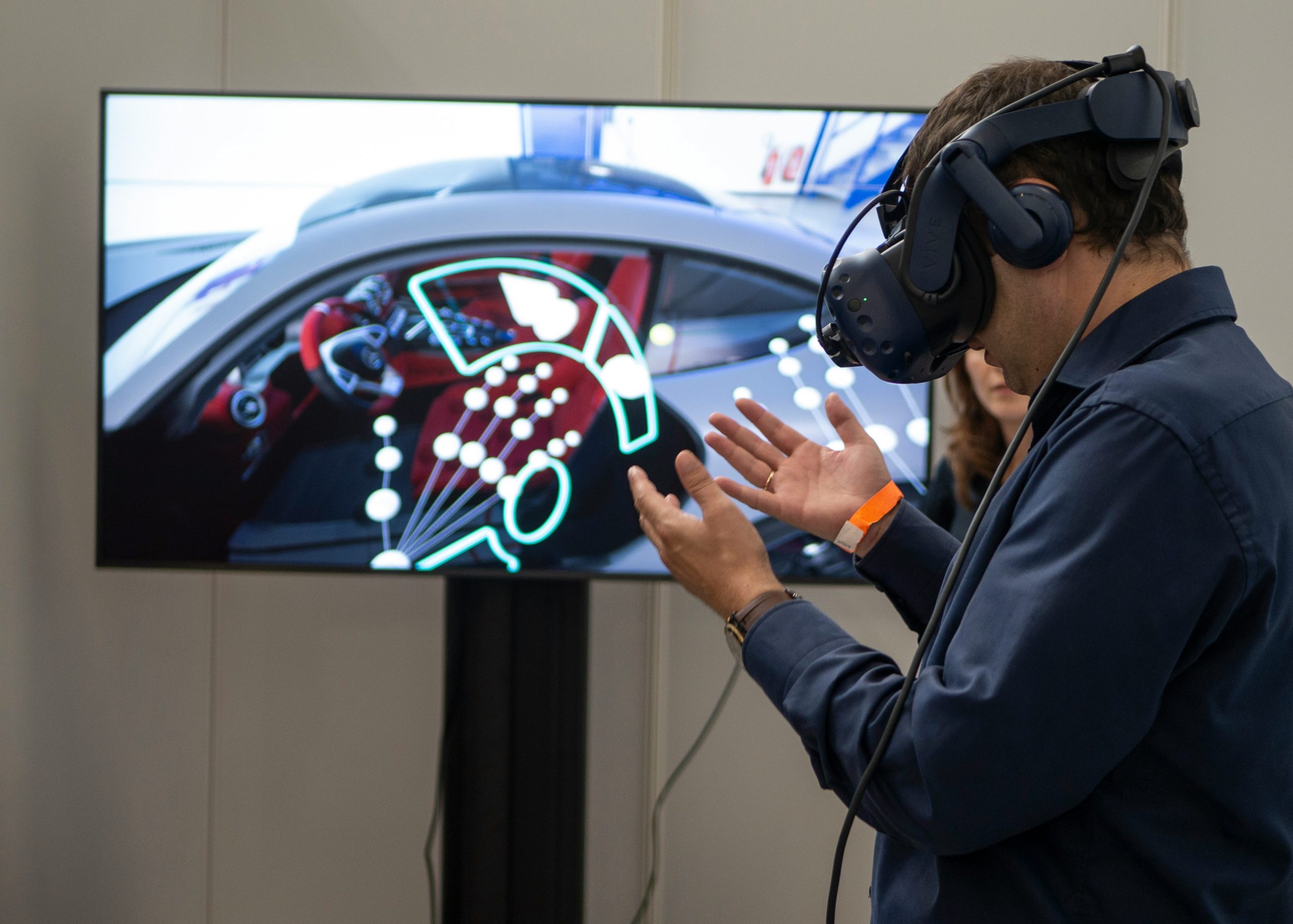Augmented Reality (AR) is quickly changing how industries function and how companies interact with their customers. AR is transforming a variety of industries, including gaming, retail, and healthcare. It does this by allowing users to superimpose digital content over the real world. This article will discuss the advantages of augmented reality (AR), look at real-world case studies that highlight its expanding influence, and investigate how AR is being used in a variety of sectors.
How does Augmented Reality work?

The technology known as “augmented reality” modifies the physical world by superimposing digital components in real time, such as sounds, visuals, and other sensory inputs. AR improves the real world without taking its place, as contrast to Virtual Reality (VR), which produces a completely digital environment. Apps for augmented reality can be accessible via smartphones, tablets, AR glasses, and even head-up displays in cars.
The Expanding Use of Augmented Reality in Different Industries
Because AR may improve decision-making processes, expedite operations, and improve user interaction, it is being adopted by a variety of industries. Here are some major industries that are using AR:
1. Augmented Reality in eCommerce and Retail
Retail and eCommerce are two notable industries where augmented reality is being used. Augmented Reality (AR) is transforming e-commerce by enabling users to “try on” furniture, makeup, and apparel virtually and in real time. Customers can preview how things look in their surroundings before making a purchase, which improves the shopping experience and lowers return rates.
IKEA’s AR application, for instance
With just their smartphones and the IKEA AR app, consumers can virtually arrange furniture in their houses. Customers can see how furniture like couches, tables, and bookcases will fit in their living rooms before making a purchase using this WebAR development platform, which lowers the uncertainty that comes with online purchasing.
2. Augmented Reality for Indoor Navigation Systems
Indoor navigation in intricate areas like airports, hospitals, and sizable shopping malls has also shown the value of augmented reality. Real-time guidance can be provided by marker-based augmented reality indoor navigation, which facilitates user navigation.
Gatwick Airport, for instance

An augmented reality (AR) navigation application has been adopted by London’s Gatwick Airport to assist travelers in finding check-in counters, gates, and baggage claim locations. Travelers can have a smooth navigating experience by simply holding up their cellphones to view arrows and directions overlayed over their surroundings.
3. Using Augmented Reality for Surgical Procedures in Healthcare
Another sector that has embraced AR to improve patient care and outcomes is healthcare. Surgeons can superimpose vital information, including CT scan or MRI pictures, in real time on a patient’s body during surgical procedures thanks to augmented reality in healthcare. This can lower risks and increase surgical precision.
Case Study: Google’s Microscope for Augmented Reality
The goal of Google’s Augmented Reality Microscope is to help pathologists diagnose illnesses like cancer. By superimposing digital images of tissue samples, the AR-powered microscope enhances diagnosis accuracy by drawing attention to possible problem regions.
4. Applications of AR in the Automotive Industry
Augmented Reality (AR) is revolutionizing the automobile sector by improving the driving experience and car production methods. This technology is playing an important part in everything from AR-powered automotive sales tools that let clients examine automobile features in real time to AR-based quality control in manufacturing.
BMW’s Heads-Up Display, for instance
BMW has incorporated augmented reality (AR) into its heads-up displays so that drivers may see crucial speed and navigational information right on the windshield. By maintaining the driver’s focus on the road, this lowers distractions and enhances the driving experience in general.
5. Augmented Reality in Gaming: Mixed Reality Games’ Ascent
AR innovation has always been at the forefront of gaming, and mixed reality games for Meta Quest devices represent the most recent development in this direction. By fusing the physical and digital worlds, augmented reality (AR) gives classic video games a new dimension and produces an engaging, interactive experience.
For instance, Pokémon Go

Among the best-selling augmented reality games ever made is Pokémon Go. With the use of their cellphones’ GPS and camera features, users may engage in real-world interactions with virtual Pokémon in the game’s mixed reality.
6. Experiences with Web-Based Augmented Reality (WebAR)
WebAR describes augmented reality experiences that are accessible via a web browser without requiring the download of an app. Because users may interact with augmented content with their current devices, AR becomes more accessible to a wider audience.
AR in marketing campaigns, for instance
More and more, brands are enticing customers with AR-enhanced marketing strategies. For its “Pepsi Max” campaign, PepsiCo developed an augmented reality (AR) experience that lets consumers engage with virtual characters and special effects by scanning a QR code with their smartphones.
7. Using Augmented Reality in Rehabilitation and Physical Therapy
Beyond surgery, AR is increasingly being used in healthcare, particularly in physical therapy and rehabilitation. With the use of technology, therapists can design unique, interactive workouts for patients recuperating from surgery or injuries. Patients can receive immediate feedback from augmented reality heads-up displays to make sure they are performing their activities correctly.
A Case Study on Augmented Reality in the Recovery of Strokes
The usefulness of AR-based physical therapy for stroke survivors was recently shown in a case study. Due to the technology’s ability to make rehabilitation activities more accurate and interesting, patients who used AR saw quicker recovery rates and increased motor function.
Advantages of Mixed Reality
AR technology has many advantages for both consumers and organizations, such as:
1. Increased Interaction with Customers
Customer engagement rises when AR enables a more personalized and interactive experience. For example, AR virtual try-on technology in retail increases customer happiness by enabling customers to test things before making a purchase.
2. Enhanced Effectiveness of Operations
AR-based quality control systems aid in the early detection of product flaws in manufacturing and other related industries. As a result, there are fewer recalls, less waste, and increased productivity.
3. Lowering Expenses
AR saves time and money by eliminating the need for physical models and testing in sectors like construction and automotive by offering virtual prototypes and simulations.
4. Improved Education and Instruction

AR is frequently utilized in professional training programs and educational environments. AR provides immersive learning experiences that enhance knowledge retention for a variety of professionals, from medical personnel learning surgical techniques to automobile technicians obtaining training on new vehicles.
5. Improved Ability to Make Decisions
AR helps experts in industries like healthcare to see complex data in real time, which helps with diagnosis and treatment planning that is more precise. To increase accuracy, surgeons can utilize augmented reality (AR) to see a patient’s anatomy while performing an operation.
The Difficulties of Augmented Reality
Even with all of its benefits, augmented reality has certain drawbacks. These include:
High Development Costs: Creating AR apps can be costly, particularly if they call for sophisticated gear or software.
Privacy Issues: AR apps that gather and handle real-world data give rise to privacy issues, particularly in public areas.
Restricted Device Compatibility: Some users’ accessibility may be limited by the fact that not all devices can run augmented reality apps.
In summary
Today’s augmented reality is a reality, changing a wide range of businesses. It is no longer a technology reserved for the future. AR is changing how we interact with the world in a number of ways, including bettering healthcare outcomes, increasing customer engagement in retail, and streamlining manufacturing processes. The promise of this technology is only now starting to be realized as WebAR and AR-powered applications like Google’s Augmented Reality Microscope continue to advance.
AR’s increasing use in industries like gaming, retail, healthcare, and the automobile shows how powerful and versatile it is. AR’s influence on boosting decision-making, engaging customers, and increasing operational efficiency will only grow as more companies use it. With its applications constantly pushing the envelope of what is feasible, augmented reality (AR) genuinely represents the next frontier of digital innovation.




